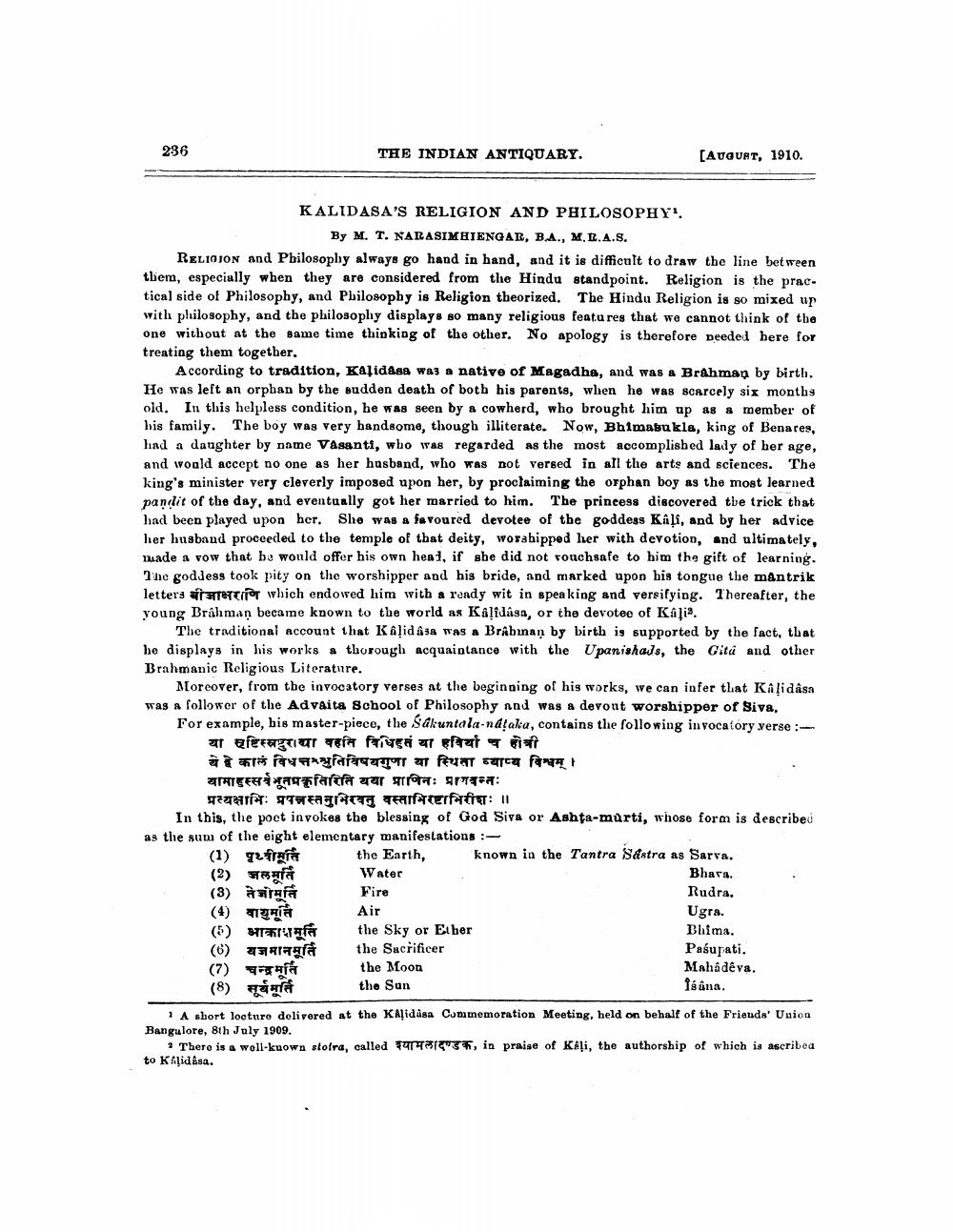________________
236
THE INDIAN ANTIQUARY.
[AUQUAT, 1910.
KALIDASA'S RELIGION AND PHILOSOPHY'.
By M. T. NARASIMHIENGAR, BA., M.L.A.S. RELIGION and Philosophy always go hand in hand, and it is difficult to draw the line between tbem, especially when they are considered from the Hindu standpoint. Religion is the prac. tical side of Philosophy, and Philosophy is Religion theorized. The Hindu Religion is so mixed up with philosophy, and the philosophy displays so many religious features that we cannot think of the one without at the same time thinking of the other. No apology is therefore needed here for treating them together.
According to tradition, Kalidasa was a native of Magadha, and was a Brahman by birth, He was left an orphan by the sudden death of both his parents, when he was scarcely six months old. In this helpless condition, he was seen by a cowherd, who brought him up as a member of his family. The boy was very handsome, though illiterate. Now, Bhimabukla, king of Benares, had a daughter by name Vasanti, who was regarded as the most accomplished lady of her age, and would accept no one as her husband, who was not versed in all the arts and sciences. The king's minister very cleverly imposed upon her, by proclaiming the orphan boy as the most learned pandlit of the day, and eventually got her married to him. The princess discovered tbe trick that had been played upon her. She was a favoured devotee of the goddess Kali, and by her advice her husband proceeded to the temple of that deity, worshipped her with devotion, and ultimately, nuade a row that bo would offer his own heal, if she did not touchsafe to him the gift of learning. The goddess took pity on the worshipper and his bride, and marked upon his tongue the mantrik letters for which endowed him with a ready wit in speaking and versifying. Thereafter, the young Brahman became known to the world as Kalidasa, or the devotee of Kali.
The traditional account that Kálid Asa was a Brabunan by birth is supported by the fact, that he displays in his works a thorough acquaintance with the Upanishads, the Gita and other Brahmanic Religious Literature.
Moreover, from the invocatory verses at the beginning of his works, we can infer that Kaļi dasa was a follower of the Advaita School of Philosophy and was a devont worshipper of Siva, For example, bis master-piece, the Sakuntala-nd!aka, contains the following invocatory verse :
या सष्टिस्म्रष्टुराया वहति विधिहुतं या हविर्या च होत्री थे कालं विधत्तम्श्रुतिविषयगुणा या स्थिता व्याप्य विश्वम् । AATTEET farcra za grrrr: Ara:
प्रत्यक्षाभिः प्रपन्नस्तनुभिरवतु वस्ताभिरष्टाभिरीशः ॥ In this, the poet invokes the blessing of God Siva or Ashta-murti, whose form is describeu as the sum of the eight elementary manifestations :
(1) qe frana the Earth, known in the Tantra Sastra as Sarva. (2) Fara Water
Bhara. (3) HAFA Fire
Rudra. (4) The Air
Ugra. (5) W afa the Sky or Ether
Bhima. (6) Ana the Sacrificer
Pasupati. (7) a the Moon
Mahadeva. (8) et the San
1sana. 1 A short locture delivered at the KAļidasa Commemoration Meeting, held on behalf of the Friends' Union Bangulore, 8th July 1909.
* There is a well-kuown stolra, called "3, in praise of Kali, the authorship of which is ascribea to Kalidasa.




